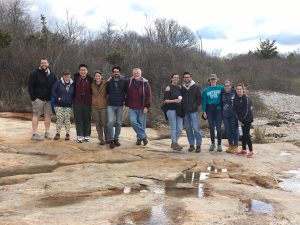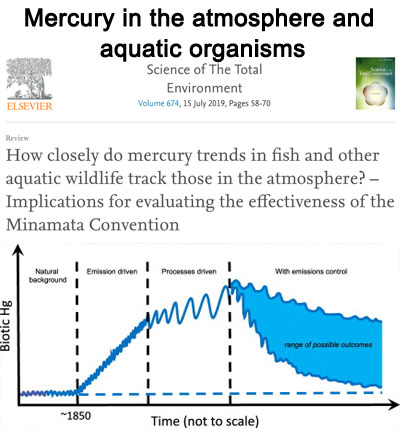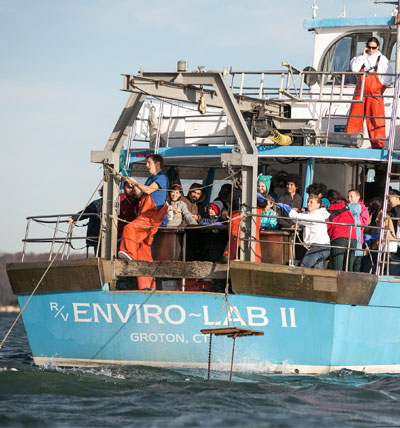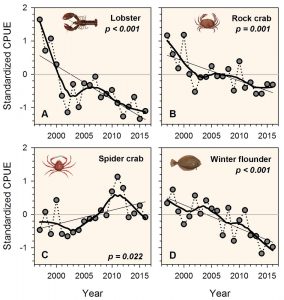Graduate students in the Geological Oceanography course investigate the local coastal morphology, and discuss impacts of rising seas on our coastline with Professor Ralph Lewis.
Month: April 2019
Long Island Sound Habitat Mapping website now available
A new website highlighting the Long Island Sound Habitat Mapping Initiative went live on Earth Day. The website provides information on the background and motivation for the mapping initiative, summaries of the field work conducted, interpretive story maps describing some of the results, links to data products and publications generated and multimedia links to images and video of at-sea operations that illustrate the beauty and complexity of the underwater habitats of the Sound.
DMS post-doctoral researcher Emma Cross publishes new brachiopod research
15 April 2019. Dr. Emma Cross from the Baumann Lab just published her latest paper about brachiopod resilience to future ocean acidification in Environmental Science & Technology. The project involved long-term culturing of a polar and a temperate brachiopod under future ocean acidification and warming conditions during Emma’s PhD-research with the British Antarctic Survey. Substantial shell dissolution posed a threat to both species under ocean acidification, with more extensive dissolution occurring in the polar species.
Unexpectedly, however, the authors also discovered that brachiopods thicken their shell from the inner shell surface when extensive dissolution occurs at the outer shell surface under ocean acidification. This important finding furthers our understanding how predicted vulnerable marine calcifiers might cope under future environmental change.
Cross, E. L., Harper, E. M. and Peck, L. S. 2019. Thicker shells compensate extensive dissolution in brachiopods under future ocean acidification. Environmental Science & Technology (published online March 29, 2019).
Canadian Journal of Zoology publishes perspective on experimental OA research by DMS faculty
15 April 2019. Today, the Canadian Journal of Zoology published a perspective on the progress and challenges of experimental ocean acidification research, written by Hannes last year as an extension of keynote lectures on this topic given at the Annual meeting of the Canadian Zoological Society (St. John’s, NL, Canada) and the Gordon Research Symposium (Waterville Valley, NH). The perspective takes stock of the progress achieved in the field over past two decades in four key areas, hoping to inspire particularly new researchers to the field to build on this foundation.
Abstract: Experimental studies assessing the potential impacts of ocean acidification on marine organisms have rapidly expanded and produced a wealth of empirical data over the past decade. This perspective examines four key areas of transfor- mative developments in experimental approaches: (1) methodological advances; (2) advances in elucidating physiological and molecular mechanisms behind observed CO2 effects; (3) recognition of short-term CO2 variability as a likely modifier of species sensitivities (Ocean Variability Hypothesis); and (4) consensus on the multistressor nature of marine climate change where effect interactions are still challenging to anticipate. No single experiment allows predicting the fate of future populations. But sustaining the accumulation of empirical evidence is critical for more robust estimates of species reaction norms and thus for enabling better modeling approaches. Moreover, advanced experimental approaches are needed to address knowledge gaps including changes in species interactions and intraspecific variability in sensitivity and its importance for the adaptation potential of marine organisms to a high CO2 world.

- Baumann, H. (2019)
Experimental assessments of marine species sensitivities to ocean acidification and its co-stressors: how far have we come?
Canadian Journal of Zoology 97:399-408
New publication of mercury levels in aquatic wildlife and the atmosphere
17 April 2019. Rob Mason was a co-author of a recent publication in Science of the Total Environment (How closely do mercury trends in fish and other aquatic wildlife track those in the atmosphere? – Implications for evaluating the effectiveness of the Minamata Convention) that provided a review of the potential timescale and magnitude of response of fish in different ecosystems to changes in inputs of mercury to the atmosphere from anthropogenic activities. The paper is a synthesis of information gathered for the 2018 Global Mercury Assessment Report, published by the United Nations Environmental Program as part of the activities of the Minamata Convention on Mercury, a globally binding treaty that has been initiated to reduce anthropogenic mercury emissions to the biosphere.
-
- Wang, F., Outridge, P.M., Feng, X., Meng, B., Heimbürger-Boavida, L.-E., and Mason, R.P. (2019)
How closely do mercury trends in fish and other aquatic wildlife track those in the atmosphere? – Implications for evaluating the effectiveness of the Minamata Convention
Science of The Total Environment 674:58-70
Grad students Sean Ryan and Halle Berger win awards at 2019 Benthic Ecology Meeting
Graduate students Sean Ryan and Halle Berger received Honourable Mention awards (top 10 graduate student presentations) for their presentations at the 2019 Benthic Ecology Meeting in St. John’s Newfoundland. Halle Berger, co-advised by Profs. Samantha Siedlecki and Catherine Matassa, was awarded for her interdisciplinary talk “Using regional oceanographic forecasts to assess the vulnerability of the Dungeness crab to climate change stressors.” Sean Ryan (advisor Catherine Matassa) was awarded for his poster “Induced herbivore resistance varies with latitude in the rockweed Fucus vesiculosus.” Sean and Halle were among ~180 student presenters at the meeting. Congratulations on your accomplishments, Halle and Sean!
New hydrothermal scavenging paper published in EPSL
The Lund lab recently published a paper in Earth and Planetary Science Letters on hydrothermal scavenging of trace metals at the East Pacific Rise. The results suggest that 230Th, a radionuclide commonly used to constrain sediment accumulation rates on the seafloor, is highly sensitive to changes in hydrothermal output, with important implications for the use of 230Th in paleoclimate and geochemical studies (https://davidlund.wixsite.com/averypointpaleo/page4).
Citizen science shows that climate change is rapidly reshaping Long Island Sound
21 March 2019. Marine Environmental Research just published a study about long-term ecological change in eastern Long Island Sound based on data collected by Project Oceanology! This non-profit ocean literacy organization has educated middle and high school students on boat trips to nearby estuarine sites for decades. For the first time, the digitization of these data allowed their quantitative evaluation, offering insights into the abiotic and biotic changes in nearshore waters of Eastern Long Island Sound.
Highlights
-
- Citizen-science observations revealed rapid warming, acidification, and dissolved oxygen loss over the past 40 years in eastern Long Island Sound
- Otter trawl catches showed significant decreases in overall species diversity and richness
- Cold-water adapted species (American lobster, winter flounder) decreased, but warm-water adapted species (spider crabs) increased since 1997





